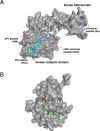Bivalent inhibitors of protein kinases
- PMID: 24564382
- PMCID: PMC4627631
- DOI: 10.3109/10409238.2013.875513
Bivalent inhibitors of protein kinases
Abstract
Protein kinases are key players in a large number of cellular signaling pathways. Dysregulated kinase activity has been implicated in a number of diseases, and members of this enzyme family are of therapeutic interest. However, due to the fact that most inhibitors interact with the highly conserved ATP-binding sites of kinases, it is a significant challenge to develop pharmacological agents that target only one of the greater than 500 kinases present in humans. A potential solution to this problem is the development of bisubstrate and bivalent kinase inhibitors, in which an active site-directed moiety is tethered to another ligand that targets a location outside of the ATP-binding cleft. Because kinase signaling specificity is modulated by regions outside of the ATP-binding site, strategies that exploit these interactions have the potential to provide reagents with high target selectivity. This review highlights examples of kinase interaction sites that can potentially be exploited by bisubstrate and bivalent inhibitors. Furthermore, an overview of efforts to target these interactions with bisubstrate and bivalent inhibitors is provided. Finally, several examples of the successful application of these reagents in a cellular setting are described.
Figures





Similar articles
-
Tinkering outside the kinase ATP box: allosteric (type IV) and bivalent (type V) inhibitors of protein kinases.Future Med Chem. 2011 Jan;3(1):29-43. doi: 10.4155/fmc.10.272. Future Med Chem. 2011. PMID: 21428824 Review.
-
Targeting diverse signaling interaction sites allows the rapid generation of bivalent kinase inhibitors.ACS Chem Biol. 2012 Mar 16;7(3):487-95. doi: 10.1021/cb200387g. Epub 2011 Dec 22. ACS Chem Biol. 2012. PMID: 22148755 Free PMC article.
-
New directions in targeting protein kinases: focusing upon true allosteric and bivalent inhibitors.Curr Pharm Des. 2012;18(20):2936-45. doi: 10.2174/138161212800672813. Curr Pharm Des. 2012. PMID: 22571662 Review.
-
The evolution of protein kinase inhibitors from antagonists to agonists of cellular signaling.Annu Rev Biochem. 2011;80:769-95. doi: 10.1146/annurev-biochem-090308-173656. Annu Rev Biochem. 2011. PMID: 21548788 Review.
-
Converting a weaker ATP-binding site inhibitor into a potent hetero-bivalent ligand by tethering to a unique peptide sequence derived from the same kinase.Org Biomol Chem. 2018 Sep 11;16(35):6443-6449. doi: 10.1039/c8ob01406j. Org Biomol Chem. 2018. PMID: 30140808
Cited by
-
Breakthroughs in modern cancer therapy and elusive cardiotoxicity: Critical research-practice gaps, challenges, and insights.Med Res Rev. 2018 Jan;38(1):325-376. doi: 10.1002/med.21463. Epub 2017 Sep 1. Med Res Rev. 2018. PMID: 28862319 Free PMC article. Review.
-
Fine-tuning probes for fluorescence polarization binding assays of bivalent ligands against polo-like kinase 1 using full-length protein.Bioorg Med Chem. 2025 Mar 1;119:118055. doi: 10.1016/j.bmc.2024.118055. Epub 2024 Dec 28. Bioorg Med Chem. 2025. PMID: 39764864 Free PMC article.
-
Development of ultra-high affinity bivalent ligands targeting the polo-like kinase 1.RSC Chem Biol. 2022 Jul 15;3(9):1111-1120. doi: 10.1039/d2cb00153e. eCollection 2022 Aug 31. RSC Chem Biol. 2022. PMID: 36128509 Free PMC article.
-
Discovery of Bivalent Kinase Inhibitors via Enzyme-Templated Fragment Elaboration.ACS Med Chem Lett. 2015 Jul 13;6(8):898-901. doi: 10.1021/acsmedchemlett.5b00167. eCollection 2015 Aug 13. ACS Med Chem Lett. 2015. PMID: 26286460 Free PMC article.
-
c-Jun N-Terminal Kinase Inhibitors as Potential Leads for New Therapeutics for Alzheimer's Diseases.Int J Mol Sci. 2020 Dec 18;21(24):9677. doi: 10.3390/ijms21249677. Int J Mol Sci. 2020. PMID: 33352989 Free PMC article. Review.
References
-
- Barr FA, Silljé HHW, Nigg EA. Polo-like kinases and the orchestration of cell division. Nat Rev Mol Cell Biol. 2004;5(6):429–440. - PubMed
-
- Benes CH, Wu N, Elia AEH, Dharia T, Cantley LC, Soltoff SP. The C2 Domain of PKCδ Is a Phosphotyrosine Binding Domain. Cell. 2005;121(2):271–280. - PubMed
-
- Bhattacharyya RP, Reményi A, Yeh BJ, Lim WA. Domains, motifs, and scaffolds: the role of modular interactions in the evolution and wiring of cell signaling circuits. Annu. Rev. Biochem. Annual Reviews. 2006;75:655–680. - PubMed
-
- Blume-Jensen P, Hunter T. Oncogenic kinase signalling. Nature. 2001;411(6835):355–365. - PubMed
Publication types
MeSH terms
Substances
Grants and funding
LinkOut - more resources
Full Text Sources
Other Literature Sources
